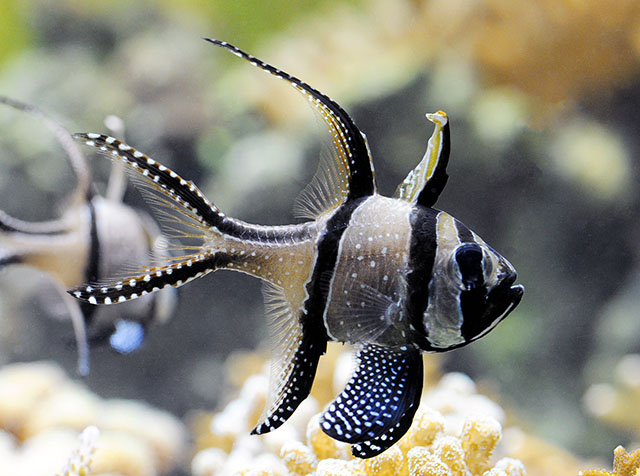| Apogonidae (Cardinalfishes), subfamily: Apogoninae |
| 8.6 cm TL (female); max.weight: 11.3 g |
|
demersal; marine; depth range 0 - 16 m |
| Western Pacific: Apparently restricted to Banggai Islands, Indonesia. Also found in several small islands off nearby eastern Taliabu Island and Luwuk vicinity (Ref. 90102). Threatened by extinction due to collection for the aquarium trade (Ref. 27438, 35396). |
|
Dorsal spines (total): 8-8; Dorsal soft rays (total): 14-14; Anal spines: 2-2; Anal soft rays: 13-13. Description: Characterized by first dorsal fin tasseled; second dorsal fin, long spike-like; caudal fin deeply forked; head and sides with three white-edged black bars; pelvic fins el=enlarged and white-spotted; second dorsal, anal and caudal fin with white-spotted black margins (Ref. 90102). |
| Common around the jetty, in silty sand bottoms with seagrass (Enhalus acoroides). Associated with Diadema setosum, the long-spined sea urchins. Individuals of 2 to 60 hover directly above the urchins, with the younger ones about 2-3 cm SL staying closer to the urchins. The fish retreat among the spines when threatened. Probably feed on small benthic and planktonic crustaceans at night. Male incubates the eggs until hatching; the large egg about 2.5 mm in diameter, with the young remaining within the mouth cavity for undetermined period after hatching (Ref. 9936, 48635). Newly hatched larvae have no planktonic period (Ref. 35886). Juveniles also use anemones for protection (Ref. 45560, 48635). Has been reared in captivity (Ref. 35417). |
|
Endangered (EN); Date assessed: 01 March 2007 (B2ab(ii,iii,iv,v)) Ref. (130435)
|
| harmless |
Source and more info: www.fishbase.org. For personal, classroom, and other internal use only. Not for publication.

